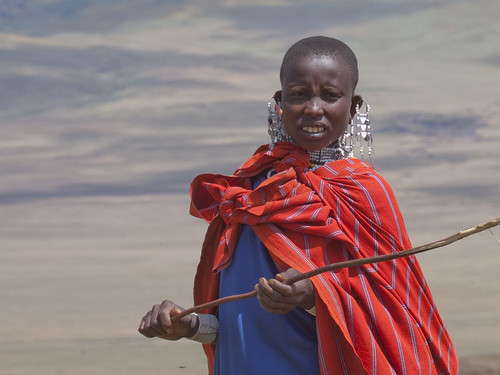Our plane was about to descend and I caught my breath as I saw a peak, completely covered with snow rising above the clouds. It was Mount Kilimanjaro, the highest mountain in Africa. As we touched down and taxied we spotted a few Zebras grazing along the runway (we later learned it was a private farm) and several raptors. Our 9 day sojourn in the African wilderness had begun. The drive from Nairobi, Kenya to Namanga, Tanzania Border, and then to Arusha was bumpy as most of the roads were under construction but we were not complaining. The country side was green, cool and fresh; the deep blue skies, a welcome relief. We proceeded to Arusha, a sleepy Tanzanian town for lunch and from there straight to the Manyara National park for a game drive.

Nairobi to Manyara National park is a 7 hour drive, we reached in time to the park gate for a short safari. Part of the Manyara lake is still outside the national park area and is used by the locals for fishing specially by the residents of the village Mto wa Mbu.. Mto wa Mbu means Mosquito river and the village is named after the river by the same name that flows near the entrance of Manyara National Park. Baboons and other bolder animals regularly stray into the village for food (specially Bananas) and water.

Lake Manyara lay in the shadow of the great rift valley. The rift valley, called as *Bondela Ufa in Swahili, means something that goes up and comes down is home to a variety of plant, animal and insect species. The 330 sqkm Manyara national park area was also home to the Masaii who named the place *Emanya after a plant (Euphorbia tirukalli ) found in region. The Masai used Emanya plant for building houses and making fence before the establishment of the park. Several fresh water rivers flow through the park and a reasonably large population of Hippopotamus is found in such fresh water pools.
**The Masaii are semi-nomads and never stay at one place for long. They move their cattle (which is the primary wealth of a Masaii) to newer fresher grazing grounds but never go very far. Since their displacement from the national parks, they have been allowed to use the resources such as water and grazing rights in and around the park so one invariably encounters a lot of them while on a wild life safari in Tanzania.

Though most of them do not like to be photographed, some of them are quick to ask “paiisa” if you click their picture. The men traditionally have a red cloth wrapped around them and women wear blue. The Masaii society is patriarchal and a man of wealth may have several wives and children. Their diet is primarily drinking cattle milk and blood (by puncturing the jugular vein of the cattle) and plant derived food. They sacrifice animal and eat meat only on ceremonial occasions. Farming is practiced by the Masaii now as a way to sustain themselves, but culturally they do not like to disturb the earth by digging it. Not even to bury the dead. The dead are left in open for the wild animals to feed.
Rajai Ali, our driver guide informed us that a lot of Masaii are now taking to education and are giving up their nomadic life but the Masaii traditions are deep rooted and are being followed by many.

Due to scarcity of time, we could manage just two game drives and cover only a quarter of this picturesque park, but, we saw a large number of mammal and avian species. Just as we entered, we encountered a large number of black Hornbills and baboons on one particular tree with long, hanging fruits. We were told this was the Sausage tree, Kigelia africana. The fruit of this tree looks like a sausage and is used as a medicine for stomach ailment by the locals. The fruit is also a favorite of baboons, elephants and Giraffes for its water content specially during the dry spell.
There were so many species we were seeing for the first time here, that we never stopped clicking. Even the commonest birds and animals here appeared exotic to us. We however were not lucky to sight even a single lion at the Manyara National park.
References: * Spellings and correct names taken from this site . Any one who has a better knowledge of Swahilli, please feel free to comment and correct me.
** confirmation of information given by our driver guide about the Masaii from here












Beautiful simply beautiful pictures, did u take the pictures? the narration gives as if i was there in the trip, nice. Congratulations!
Thank you Dr. Birendra. Yes, I took the pictures 🙂
Amazing portrait of the Masaii shepherd girl. Congratulations 🙂
Thank you, Nupur, happy that you like it 🙂
Wonderful description and photographs. I am going to Kenya, Tanzania and Uganda at the end of the month with our eldest daughter, so I am extra interested to read your account.
Thank you, Greg. Soon I will post about the other places we visited (Serengeti and Ngorongoro). So visit this blog again 🙂 and wish you a lovely trip.
Absolutely stunning photographs..
Feels like I am there, all over again
Lovely post!
Thank you Sukhada. More photos and write up on Serengeti coming up later today 🙂
Oops! How do they wear such big earrings. My wife complained when i bought her a little big one at one of the exhibition we visited. I should show her this photograph.
South indians are always proud of their dark complexion. These photographs will make them put their heads down in shame.